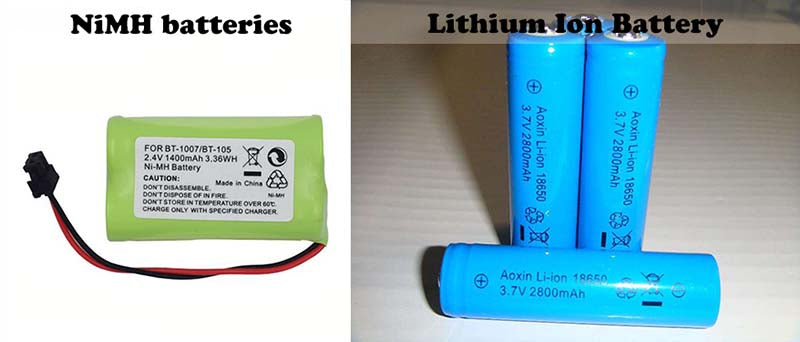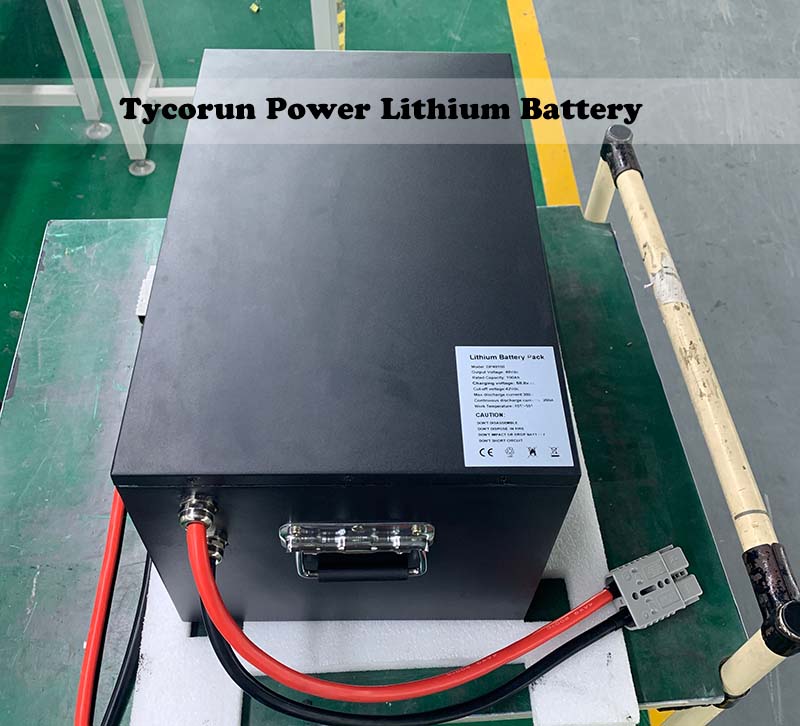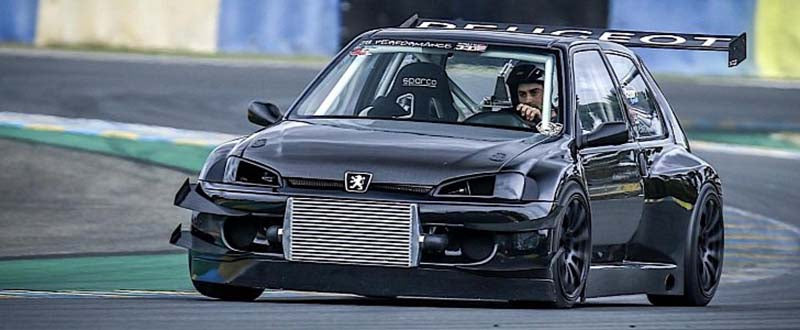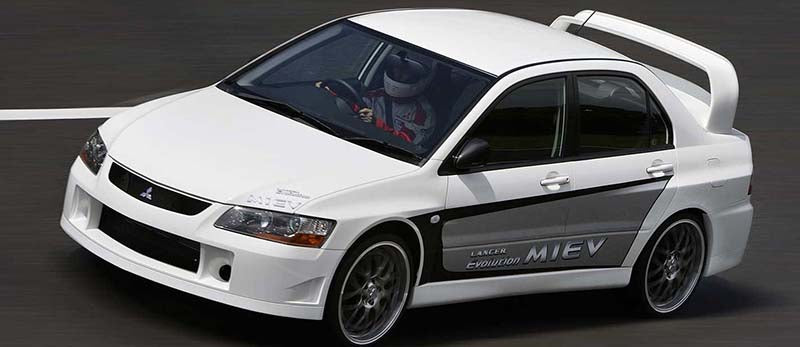
The 20th century will be the century of "electrochemical combustion", and fuel cells with high efficiency and non-polluting will replace the inefficient and polluting coal-fired steam engines. - Ostwald D
The advent of the battery started the century-old history of electric vehicles. From lead-acid batteries to nickel-cadmium batteries, nickel-metal hydride batteries and lithium batteries, the batteries themselves have experienced ups and downs for a century, and they have gained a place in the automotive power battery market by virtue of their respective advantages.

Figure: NiMH and Lithium batteries
NiMH and Lithium batteries
Since the 1990s, nickel-oxygen batteries have been the main force of vehicle power batteries. In an agreement signed by the US-ABC in 1991, nickel-metal hydride power batteries were regarded as the medium-term development goal of the DOE-USABC plan e, and 26.2 billion US dollars were invested in research and development. At the end of 1997, GM-Ovonic started mass production of nickel-metal hydride power batteries, and in 1998 further expanded the annual output. At the same time, the Japanese government has also launched a $1.6 billion project involving 11 companies to develop nickel-metal hydride power batteries for vehicles.
Well-known companies producing NiMH batteries include Japan's Panasonic Corporation, American Energy Conversion Corporation, Germany's Varta Corporation and France's SAFT Corporation. Nickel-metal hydride batteries are quite mature in application and technology, and have entered the commercialization stage, and are widely used in electric bicycles, motorcycles, tool vehicles, pure electric cars and hybrids.
powered car. According to the analysis report of Japan's Nomura Research Institute in 2005, as of that year, the application of nickel-metal hydride batteries in hybrid vehicles has accounted for 95%. High-power nickel-metal hydride batteries are the development trend and mainstream application in the short and medium term in the future.
According to experts' estimates, from 2006 to 2020, the application ratio of lithium batteries in automobiles will rise to 40%. At the end of the 20th century, the technology of electric vehicles has been quite mature, and the bottleneck is still short driving range, that is, the energy density of batteries is low. In 1992, Sony successfully developed lithium batteries, which were first used in portable electronic devices. Lithium batteries have high energy density, high output voltage, wide operating temperature range and long life. These advantages are exactly what the electric vehicle power supply pursues. Compared with traditional batteries, the weight of lithium batteries is half that of nickel-cadmium or nickel-hydrogen batteries of the same capacity, and the volume is 40% to 50% of nickel-cadmium batteries and 20% to 30% of nickel-hydrogen batteries. The working voltage of a single lithium-ion battery is 3.7 volts, which is equivalent to 3 nickel-cadmium or nickel-metal hydride batteries connected in series. Lithium-ion batteries do not contain harmful metals such as cadmium, lead, and mercury. Experts predict that large-capacity power lithium batteries will become the main power source for electric vehicles in the 21st century.

Figure: Power lithium battery diagram
Since the advent of lithium batteries, research and development work around them has continued, and lithium polymer batteries were developed in the late 1990s. Dr. Goodenough, a professor at the University of Texas in the United States, is the first international scholar to study lithium iron phosphate materials. He discovered lithium iron phosphate cathode materials in 1997 and applied for related patents, so he is called "the father of lithium iron phosphate" by the academic community. ", after 2002, lithium iron phosphate power battery came out. It also sparked a multinational patent battle in the early 2000s.
In 2006, a super-hot power tool combination launched by B&.D, the world's largest electric hand tool company, triggered this multinational patent battle for lithium iron phosphate batteries. In September of the same year, the University of Texas filed a patent lawsuit against B&D and A123 Systems, the battery supplier of this product, at the Dala Judicial Court, accusing this product of “illegal manufacture and sale” of infringing the lithium iron phosphate owned by the University of Texas. Battery patent rights. Subsequently, the University of Texas filed a patent lawsuit against companies such as Vaillant, claiming damages as high as $350 million to $500 million.

Figure: B&.D power tool combination that caused a multinational patent war
This patent lawsuit involves Canadian national public utility Quebec Hydro, Canadian Phostech Lithium, German chemical phosphate fertilizer company SUED-CHEMIE, Japanese telecom giant NTT DoCoMo and American battery manufacturer Valence and many other powerful companies. company. The patent dispute for lithium iron phosphate batteries has inadvertently become a contest between countries, and the potential business opportunities behind it are undoubtedly huge.
Goodenough said in an interview with the media that he hopes that all issues related to the patent dispute can be properly resolved before his death, and that he will also donate these damages and royalties to charities.
The lithium iron phosphate power battery is a revolution in the history of lithium batteries. Compared with the previous lithium batteries, it shows better high temperature characteristics and safety, and is more suitable for the application of electric vehicles. BYD is a Chinese private enterprise that has become popular by relying on "iron batteries (lithium iron phosphate batteries)".
Cooperation between car dealers and battery dealers
The start of cooperation between car manufacturers and battery manufacturers is a landmark event for power batteries to enter the automotive field. Since 2001, Japan's Toyota Motor Corporation and Panasonic Electric Corporation have jointly developed vehicle power batteries.
In 2008, Bosch Electric Corporation and Samsung Corporation jointly established a hybrid electric vehicle battery joint venture, dedicated to the development of a new generation of vehicle power batteries. In the same year, Nissan Motor Corporation and NEC Corporation jointly spent 20 billion yen to take the lead in mass-producing lithium batteries for vehicles in the world.
From 1997 to 2007, it was a decade when power batteries gradually entered the automotive field, and it was also a very important decade in the history of electric vehicles. During this decade, well-known electric vehicles such as the Peugeot 106 appeared, and electric vehicle technology has developed rapidly.

Figure: Peugeot 106 and Bellinger
Peugeot 106 and Bellinger
In 1997, the first relevant driving performance test of lithium battery electric vehicles in Europe was conducted in the Poiton-Charentes region of France, including the famous Peugeot 106. The lithium battery it uses is provided by SAFT, with a driving range of up to 124 kilometers, leaving a splendid stroke in the history of electric vehicles. Subsequently, Citroen launched the Bellinger pure electric vehicle. Up to now, Bellinger has experienced 12 years of ups and downs, and has formed its own unique style in appearance and function, and has been listed in the European market, the American market and the Asian market one after another.
In-wheel motor
In 2005, Mitsubishi launched the Evo-MIEV pure electric vehicle, which is based on the Evo-IX as a development prototype, replacing the traditional 2.0L turbocharged gasoline engine with an electric motor and a battery. Notably, the Evo-MIEV has in-wheel motors on each wheel. Mitsubishi also officially announced its entry into the field of four-wheel drive with this move.
The application of in-wheel motors is a revolutionary advancement in the history of electric vehicles. The so-called in-wheel motor-driven electric vehicle is to install the electric motor directly on the driving wheel, and the power is directly transmitted to the wheel through the electric motor to drive the vehicle. This drive form bids farewell to the transmission system of traditional internal combustion engine vehicles, and realizes distributed power control, which can control each driving wheel separately, which is more flexible and convenient. At the same time, the space of the original centralized motor is saved, which is more conducive to the overall layout and shape design of the vehicle. Using electronic wire control technology, the original mechanical transmission system is omitted, and the transmission efficiency is improved. Four-wheel drive has received widespread attention from academia and engineering, and in-wheel motor technology has also become a research hotspot for a while.

Figure: Mitsubishi Evo-MIEV pure electric vehicle
The soft underbelly of electric vehicles
Since the development of electric vehicles, the technology of power source and driving motor has been quite mature. Even the imperfect infrastructure problem that has plagued people in the past has also been solved to a certain extent with the construction of power grid, the improvement of charging technology and the use of battery rental and sales. So what are the electric cars waiting for?
At the same time as the introduction of the Chevrolet Volt, General Motors provided the car's customers with a lease of the corresponding type of battery, in order to reduce the cost of using electric vehicles and compete with gasoline vehicles. In 2008, Portugal signed cooperation agreements with carmakers Renault of France and Nissan of Japan to build a network of electric vehicle charging stations in Portugal, as a way to encourage widespread use of electric vehicles.
Short battery pack life is also an issue to be addressed in the commercialization of electric vehicles. Taking the promising lithium battery as an example, the performance of the single battery can fully meet the practical needs. However, when hundreds of single cells are combined into a power battery pack, the performance of the single cells is inconsistent, which may lead to battery packs. Lifespan is greatly shortened. The life of the single battery produced under the current conditions has exceeded 2,000 times, while the life of the battery pack is only 500 times. The immature battery grouping technology makes the overall cost of electric vehicles higher. The solution to the problem of power battery performance consistency depends on the improvement of the manufacturing process and equipment level, as well as the intelligence of the battery management system.
At present, the driving range of pure electric vehicles is not comparable to that of internal combustion engine vehicles. The driving mileage of an electric vehicle refers to the longest mileage that an electric vehicle can reach under certain operating conditions when the battery is fully charged to the lowest dischargeable state of the battery. The low energy density of batteries greatly limits the driving range of electric vehicles. The mileage of traditional vehicles after refueling is generally 300-500 kilometers, while pure electric vehicles can usually only reach 100-250 kilometers. For example, Ford's "Ford Focus BEV" has a driving range of 129 kilometers, while Nissan's "LEAF" has a driving range of only 100 kilometers. Audi's "e-tron" launched in 2009 has a driving range of only 248 kilometers. .
Electrode materials are an important factor affecting the energy density of batteries. Therefore, before the emergence of new electrode materials, major manufacturers are committed to the research and development of urban electric vehicles. For urban working conditions, the driving range of 60 to 80 kilometers can basically meet the needs of use. For inter-city or long-distance transportation, pure electric vehicles cannot meet the demand, and fuel cell vehicles, which do not rely on charging, provide another possible solution. It not only does not need to consume non-renewable petroleum resources, but also does not produce pollution. Compared with pure electric vehicles, fuel cell vehicles can continue to drive after only a few minutes of hydrogen refueling, and the driving range is comparable to gasoline vehicles.